Discover 11 hidden attractions, cool sights, and unusual things to do in Conwy (United Kingdom). Don't miss out on these must-see attractions: Conwy Castle, Smallest House in Great Britain, and Plas Mawr. Also, be sure to include Royal Cambrian Academy of Art in your itinerary.
Below, you can find the list of the most amazing places you should visit in Conwy (Wales).
Table of Contents
Conwy Castle
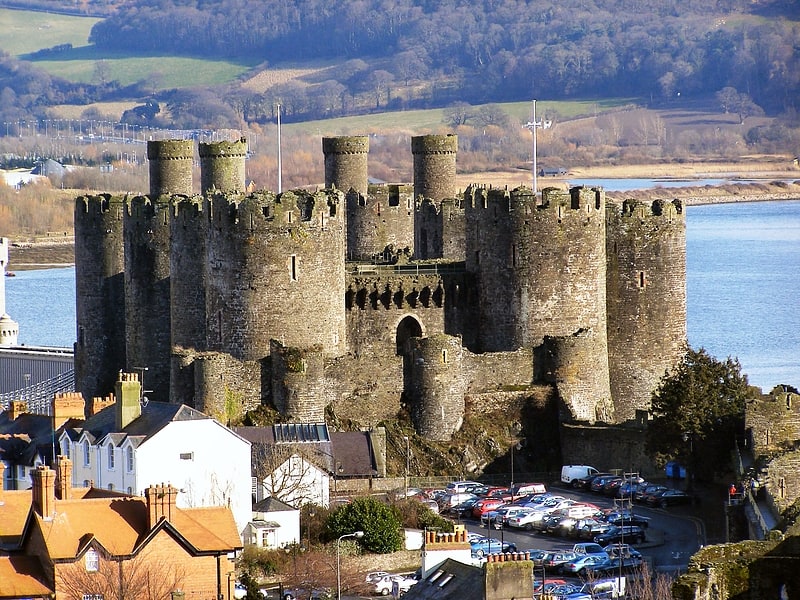
Massive, imposing 13th-century fortress. Conwy Castle is a fortification in Conwy, located in North Wales. It was built by Edward I, during his conquest of Wales, between 1283 and 1287. Constructed as part of a wider project to create the walled town of Conwy, the combined defences cost around £15,000, a huge sum for the period. Over the next few centuries, the castle played an important part in several wars. It withstood the siege of Madog ap Llywelyn in the winter of 1294–95, acted as a temporary haven for Richard II in 1399 and was held for several months by forces loyal to Owain Glyndŵr in 1401.
Following the outbreak of the English Civil War in 1642, the castle was held by forces loyal to Charles I, holding out until 1646 when it surrendered to the Parliamentary armies. In the aftermath, the castle was partially slighted by Parliament to prevent it being used in any further revolt, and was finally completely ruined in 1665 when its remaining iron and lead was stripped and sold off. Conwy Castle became an attractive destination for painters in the late 18th and early 19th centuries. Visitor numbers grew and initial restoration work was carried out in the second half of the 19th century. In the 21st century, the ruined castle is managed by Cadw as a tourist attraction.
UNESCO considers Conwy to be one of "the finest examples of late 13th century and early 14th century military architecture in Europe", and it is classed as a World Heritage Site. The rectangular castle is built from local and imported stone and occupies a coastal ridge, originally overlooking an important crossing point over the River Conwy. Divided into an Inner and an Outer Ward, it is defended by eight large towers and two barbicans, with a postern gate leading down to the river, allowing the castle to be resupplied from the sea. It retains the earliest surviving stone machicolations in Britain and what historian Jeremy Ashbee has described as the "best preserved suite of medieval private royal chambers in England and Wales". In keeping with other Edwardian castles in North Wales, the architecture of Conwy has close links to that found in the Kingdom of Savoy during the same period, an influence probably derived from the Savoy origins of the main architect, James of Saint George.[1]
Address: Rose Hill St, LL32 8AY Conwy
Smallest House in Great Britain

16th-century cottage, 1.8 metres wide. The Smallest House in Great Britain, also known as the Quay House, is a tourist attraction on the quay in Conwy, Wales. It is reputed to be smallest house in the United Kingdom.[2]
Address: The Quay, LL32 8BB Conwy
Plas Mawr

Heritage building in Conwy, Wales. Plas Mawr is an Elizabethan townhouse in Conwy, North Wales, dating from the 16th century. The property was built by Robert Wynn, a member of the local gentry, following his marriage to his first wife, Dorothy Griffith. Plas Mawr occupied a plot of land off Conwy's High Street and was constructed in three phases between 1576 and 1585 at a total cost of around £800. Wynn was known for his hospitality, and the household was supported by Wynn's local dairy herds, orchards and gardens. On his death he laid out complex instructions for dividing his estate; the resulting law-case took years to resolve, effectively preventing the redevelopment of the house and preserving it in its original condition.
After 1683 Plas Mawr passed into the hands of the Mostyn family and ceased to be used as a family home. It was rented out for various purposes during the 18th and 19th centuries, including for use as a school, cheap lodgings and finally as the headquarters of the Royal Cambrian Academy of Art. In the 20th century the house became increasingly well known for its preserved Elizabethan architecture, but the costs of maintenance grew considerably and its condition deteriorated. The Welsh heritage agency Cadw took over the management of the property in 1993 and carried out an extensive, 42-month-long restoration project at a total cost of £3.3 million. With many of its rooms redecorated to resemble their condition in 1665, and replanted Renaissance gardens, it is now run as a tourist attraction.
Architecturally, Plas Mawr is almost unchanged from the 16th century, and the historian Rick Turner considers the house to be "the finest surviving town house of the Elizabethan era". Plas Mawr shows a blend of continental Renaissance and local North Wales influences, with an innovative floor-plan and architectural detailing. The house still retains much of its original plasterwork, which incorporates symbols, badges and heraldry, which the historian Peter Smith has described as "the most perfect and the most complete memorial to Elizabethan Wales." The architecture of the house influenced other contemporary projects in North Wales, and was later copied during the 19th and 20th centuries in buildings around the town of Conwy, including the local police station and nearby hotel.[3]
Address: Chapel St, LL32 8DE Conwy
Royal Cambrian Academy of Art

Art gallery in Conwy, Wales. The Royal Cambrian Academy of Art is a centre of excellence for art in Wales. Its main gallery is located in Conwy and it has over a hundred members.[4]
Address: Crown Ln, LL32 8AN Conwy
Conwy Railway Bridge
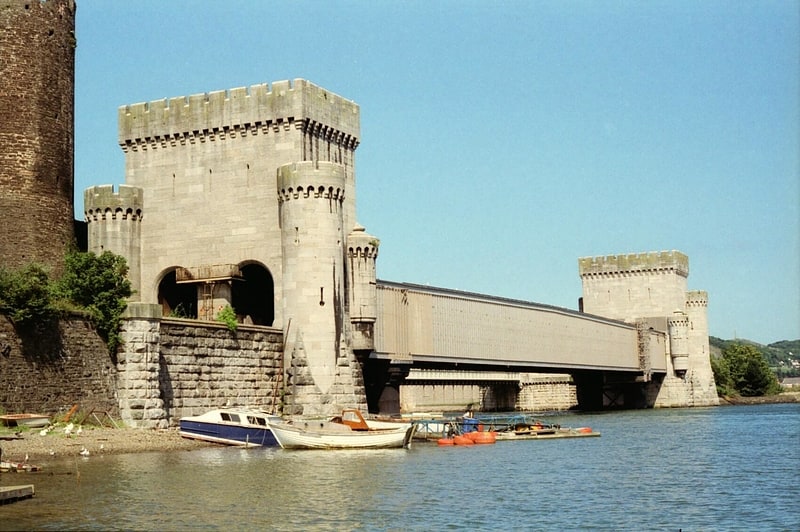
Tubular bridge in Conwy, United Kingdom. The Conwy Railway Bridge carries the North Wales coast railway line across the River Conwy between Llandudno Junction and the town of Conwy. The wrought iron tubular bridge, which is now Grade I listed, was built in the 19th century. It is the last surviving example of this type of design by Stephenson after the original Britannia Bridge across the Menai Strait was destroyed in a fire in 1970 and replaced by a two-tier truss arch bridge design.
The Conway Railway Bridge was designed by railway engineer Robert Stephenson in collaboration with William Fairbairn and Eaton Hodgkinson. The original plan had been for suspension bridge complementing Thomas Telford's Conwy Suspension Bridge of 1826. After Stephenson's appointment as chief engineer, the design was changed because a suspension bridge was considered unsuitable for trains. Stephenson and his collaborators invented the wrought-iron box-girder structure to bridge the River Conwy in a single span.
During May 1846, groundwork for the bridge commenced. The architect Francis Thompson (architect) dressed the pylons at either end as barbicans, with crenellated turrets, arrow slits and bartizans to complement the adjacent Conwy Castle. Unusually, the tubes were completed onshore before being attached to pontoons, floated along the river and jacked into position between the abutments. The bridge was officially opened in 1849. The bridge endorsed the construction of the larger Britannia Bridge. During 1899, the tubular sections were reinforced with cast iron columns to reduce the load on the span across the river. In September 1950, Conwy Tubular Bridge was recognised as being a Grade I listed building; it is also a scheduled monument (CN167).[5]
Aberconwy House
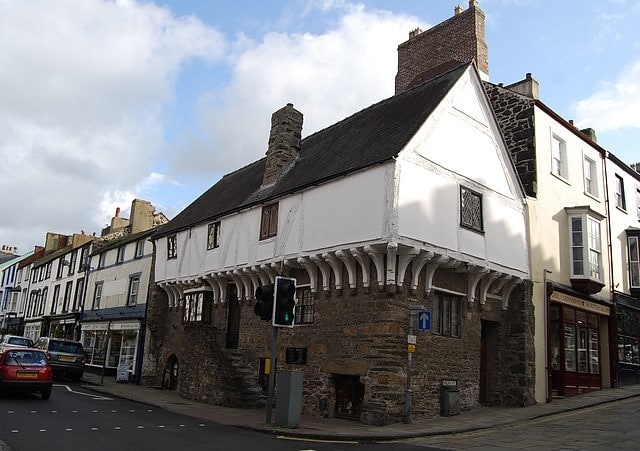
Building in Conwy, Wales. Aberconwy House, 2 Castle Street, Conwy, Wales is a medieval merchant's house and one of the oldest dateable houses in Wales. Constructed in the 15th century it is, along with Plas Mawr, one of the two surviving merchant's houses within the town. Its historical and architectural importance is reflected in its status as a Grade I listed building. The house is administered by the National Trust.[6]
Address: Castle Street, LL32 8AY, Conwy
Conwy Suspension Bridge
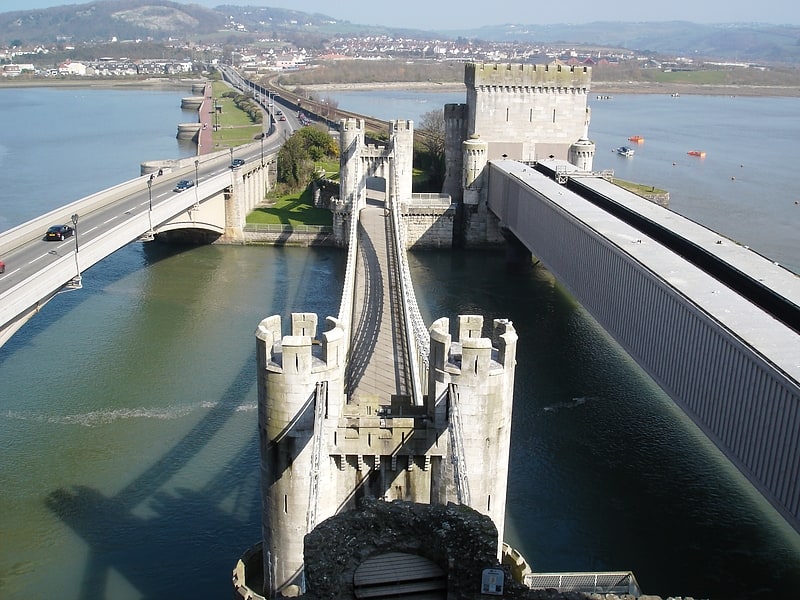
Suspension bridge in the United Kingdom. The Conwy Suspension Bridge is a Grade I-listed structure and is one of the first road suspension bridges in the world. Located in the medieval town of Conwy in Conwy county borough, North Wales, it is now only passable on foot. The bridge is now in the care of the National Trust. It originally carried the A55 road from Chester to Bangor.[7]
Bodnant Garden
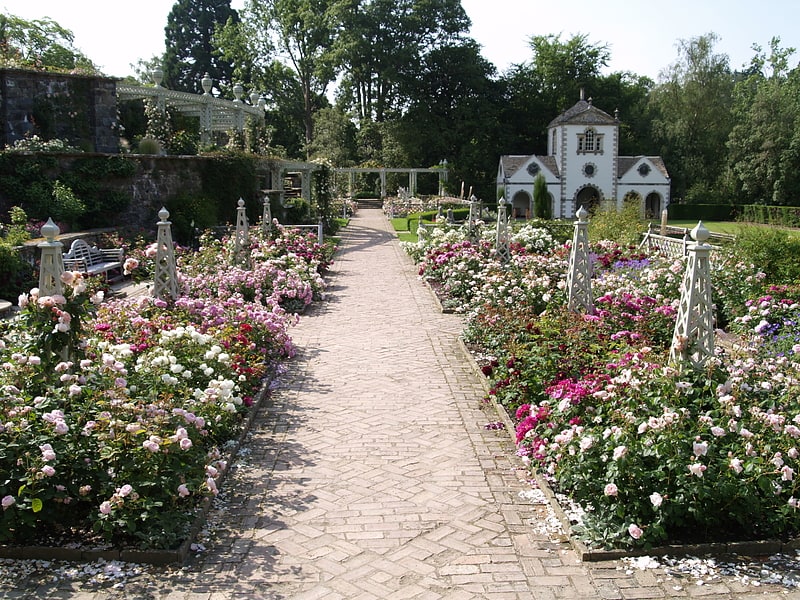
Botanical garden in Tal-y-Cafn, Wales. Bodnant Garden is a National Trust property near Tal-y-Cafn, Conwy, Wales, overlooking the Conwy Valley towards the Carneddau mountains.
Founded in 1874 and developed by five generations of one family, it was given to the National Trust in 1949. The garden spans 80 acres of hillside and includes formal Italianate terraces, informal shrub borders stocked with plants from around the world, The Dell, a gorge garden, areas of woodland garden with a number of notable trees and a waterfall. Since 2012, new areas have opened including the Winter garden, Old Park Meadow, Yew Dell and The Far End, a riverside garden. Furnace Wood and Meadow opened in 2017. There are plans to open more new areas, including Heather Hill and Cae Poeth Meadow.
Bodnant Garden was visited by over 260,000 people in 2019 and is famous for its Laburnum arch, the longest in the UK, which flowers in May and June. The garden is also celebrated for its link to the plant hunters of the early 1900s whose expeditions formed the base of the garden's four National Collections of plants – Magnolia, Embothrium, Eucryphia and Rhododendron forrestii.[8]
St Mary and All Saints Church

The Church of St Mary's & All Saints is the parish church of Conwy, Wales in the United Kingdom. It was originally the Cistercian Aberconwy Abbey, but in 1283 King Edward I of England moved the Abbey to Maenan. The parish registers date back to 1541.
The foundations of the church date back to 1172, and the Aberconwy Abbey was completed in 1186. Since then the church has grown and changed. The East and West-end buttresses and parts of the walls, particularly on the North side, are original. In the fourteenth century, the church received the lower portion of its tower, the South transept, and the North and South porches. A room north of the tower was enclosed to serve as a charnel house. The fifteenth century saw the completion of the tower, and the installation of the rood screen and the early Tudor period baptismal font. This includes Sir Richard Pole's, badge, (an eagle's claw grabbing a fish) who was the constable of Conwy castle between 1488 and 1504.
In the sixteenth century the roofs over the aisles were raised. Next to the altar at the south end is the tomb of Robert Wynne, a major benefactor of St Mary's, and the builder of Plas Mawr on Conwy's High Street. The chancel floor was raised at a later date, and in 1872 the roof of the nave was raised by Gilbert Scott. At some point the South window of the transept was reconstructed and the clerestory windows were reset to where they now remain. Also in the nineteenth century, Lord Penrhyn donated the tower clock. In 1921 the church received a memorial chapel on the church's north side, and five years later the vestry was enlarged. In 1949 the former charnel house became the Parish Room. The church holds a number of objects of interest dating back to medieval times, and two windows in the nave's south aisle made by the William Morris company, a workshop with associations with the Pre-raphaelite artist Edward Burne-Jones.
In the summer months the church is a venue for Conwy's Classical Music Festival, a series of weekly hour-long concerts by professional musicians.[9]
Address: St Mary's Church Rose Hill Street, LL32 8LD Conwy
Sarn Helen
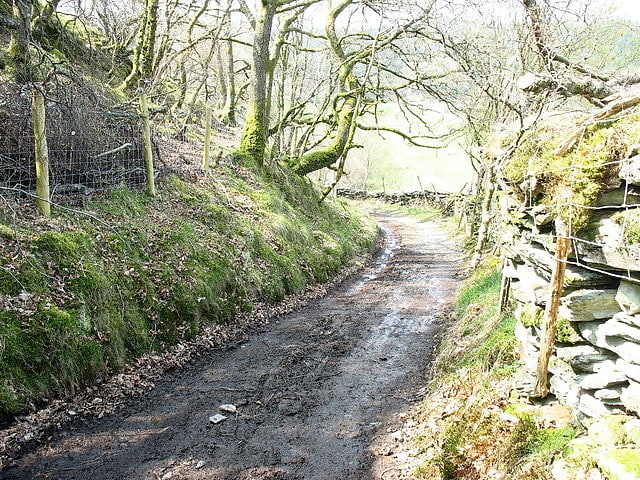
Road. Sarn Helen refers to several stretches of Roman road in Wales. The 160-mile route, which follows a meandering course through central Wales, connects Aberconwy in the north with Carmarthen in the west. Despite its length, academic debate continues as to the precise course of the Roman road. Many sections are now used by the modern road network while other parts are still traceable. However, there are sizeable stretches that have been lost and are unidentifiable.
The route is named after Saint Elen of Caernarfon, a Celtic saint, whose story is told in The Dream of Macsen Wledig, part of the Mabinogion. She is said to have ordered the construction of roads in Wales during the late 4th century.[10]
Conwy town walls
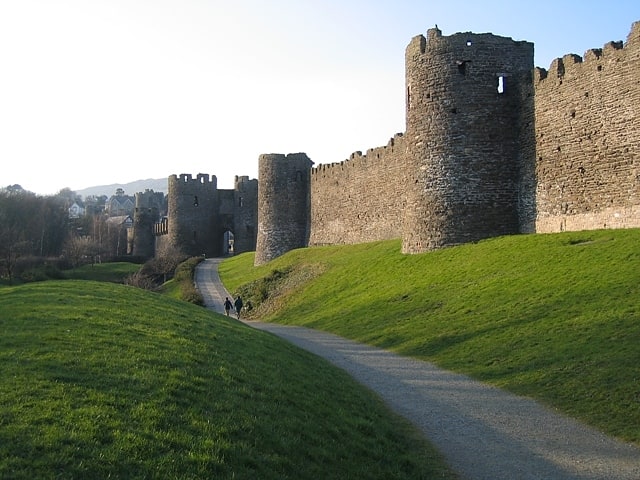
Conwy's town walls are a medieval defensive structure around the town of Conwy in Wales. The walls were constructed between 1283 and 1287 after the foundation of Conwy by Edward I, and were designed to form an integrated system of defence alongside Conwy Castle. The walls are 1.3 km long and include 21 towers and three gatehouses. The project was completed using large quantities of labourers brought in from England; the cost of building the castle and walls together came to around £15,000, a huge sum for the period. The walls were slightly damaged during the rebellion of Owain Glyndŵr in 1401, but political changes in the 16th century reduced the need to maintain such defences around the town. The fortifications were treated sympathetically during the development of the road and railway systems in Conwy during the 19th century and survived largely intact into the modern period. Today the walls form part of the UNESCO world heritage site administered by Cadw. Historians Oliver Creighton and Robert Higham describe the defences as "one of the most impressive walled circuits" in Europe.[11]